How to Create a Complete Preventive Dental Care Plan for Your Family in 2025

Are Dental Problems Draining Your Family Budget?
Did you know that most Indian families spend up to 60% more on dental care than they need to? Welcome to TaniAmit’s comprehensive guide on creating a prevention-focused dental care plan that protects both your family’s smiles and financial health.

As India’s unique dentist-banker team with 18+ years of combined expertise, we’ve witnessed firsthand how strategic prevention can save families ₹15,000+ annually on dental expenses. The key? A well-structured preventive dental care plan tailored to your family’s specific needs and risk factors.
“We were spending way too much on emergency dental treatments. TaniAmit showed us how spending a little on prevention saves a fortune. Our family dental costs are down 60% this year!” — Rajesh & Meera K., Parents, Bangalore
In this definitive guide, we’ll walk you through our proven 7-step framework for creating a prevention-focused approach that dramatically reduces costs while improving oral health outcomes for every family member. Ready to transform your family’s dental future? Let’s begin!
Reach out to us for any question or content/copywriting needs.
Why Preventive Dental Care Is Your Family’s Financial Superpower
Most Indian families view dental care as an unavoidable expense, but financially savvy families recognize it as an investment with exceptional returns. Here’s why prevention delivers such powerful financial benefits:
The Startling Cost Difference
The numbers reveal a compelling truth—preventive care costs a fraction of treatment:
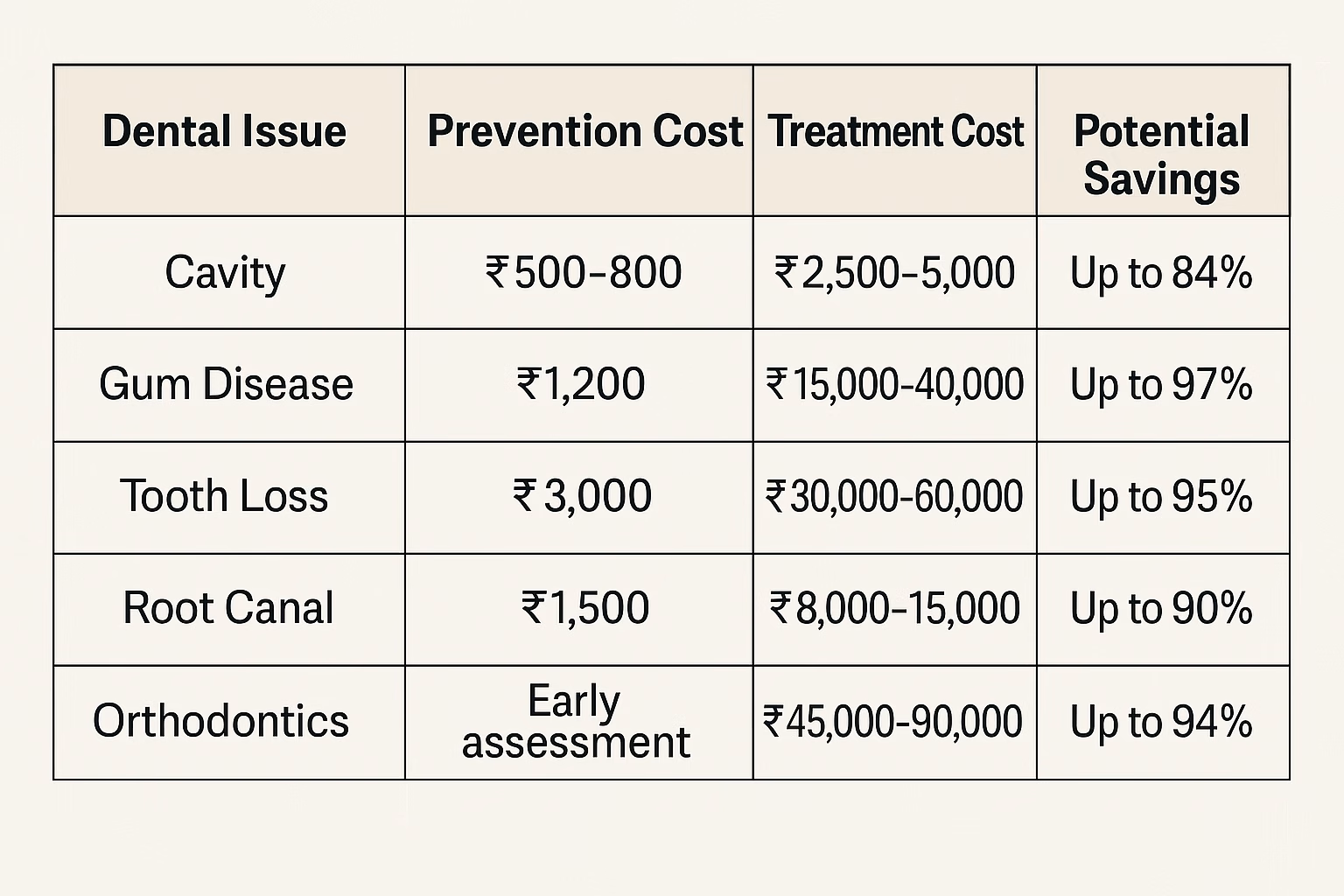
The Compound Effect
Similar to how compound interest grows wealth over time, preventive dental care creates a compounding health effect that:
- Prevents small issues from becoming costly emergencies
- Maintains natural oral structures that would be expensive to restore
- Reduces lifetime dental care costs by 70-80% for most families
- Creates generational health benefits as children learn good habits
- Improves overall systemic health, reducing medical expenses
The Hidden Costs You’re Avoiding
Beyond direct treatment expenses, dental problems generate numerous indirect costs:
- Lost Productivity: India loses an estimated 164 million work hours annually to dental problems
- Educational Impact: Children with dental pain miss school and struggle to concentrate
- Pain Management Costs: Ongoing medication expenses for chronic dental issues
- Quality of Life Reduction: Discomfort, self-confidence issues, and social limitations
- Nutritional Compromises: Dietary restrictions that affect overall health
- Sleep Disruption: Dental pain often leads to sleep disturbances and reduced productivity
Step 1: Assess Your Family’s Current Dental Health Status
Before creating your prevention plan, you need a complete picture of where your family stands now.
Conduct a Family Dental Inventory
Document these key elements for each family member:
- Last dental visit date and findings
- Existing dental work (fillings, crowns, bridges, implants)
- Current symptoms or concerns (sensitivity, pain, bleeding gums)
- Family history of dental issues (genetics significantly influence risk)
- Current oral hygiene practices and products
- Diet patterns and habits that impact dental health
Identify High-Risk Family Members
Some family members require enhanced preventive attention:
- Children ages 6-14: When permanent teeth emerge and decay risk peaks
- Pregnant women: Hormonal changes increase gum disease risk by 65%
- Family members with diabetes: 3× higher risk for severe gum disease
- Orthodontic patients: Braces create additional plaque retention areas
- Adults over 60: Medication-induced dry mouth dramatically increases decay risk
- Individuals with acid reflux: Stomach acid erodes dental enamel
- Smokers and tobacco users: Higher risk for gum disease and oral cancer
Essential Questions for Your Next Dental Checkup
Prepare these questions to maximize the value of your professional visits:
- “What specific risk factors does each family member have based on their oral examination?”
- “Which preventive treatments would provide our family the best return on investment?”
- “How often should each family member have preventive checkups based on their individual risk level?”
- “What early warning signs should we monitor between professional visits?”
- “Which preventive home care products do you recommend specifically for our family’s unique needs?”
- “Are there any emerging preventive technologies we should consider investing in?”
Step 2: Calculate Your Preventive Care ROI
Smart families approach dental care as both a health and financial decision, analyzing the return on their preventive investments.

Understanding Your Prevention Economics
Effective preventive care delivers remarkable financial returns:
- Prevents costly emergency treatments (average ₹8,000-15,000 per incident)
- Reduces treatment complexity when issues are caught early
- Preserves natural tooth structure, avoiding expensive restorations
- Minimizes long-term maintenance costs of dental work
- Reduces lifetime dental spending by up to 80%
Identify Your “Big Win” Preventive Measures
Not all preventive measures deliver equal value. Focus on these high-ROI interventions:
For Children (Highest ROI)
- Dental sealants: Prevent up to 80% of cavities at a fraction of filling costs
- Professional fluoride treatments: Reduce decay by 33% for just ₹500-800 per application
- Early orthodontic assessment: Identifying issues at age 7-8 can save ₹50,000+ in complex treatments later
- Sports mouthguards: Prevent dental trauma costing ₹5,000-60,000 per tooth
- Habit interventions: Addressing thumb-sucking and pacifier use early prevents ₹40,000+ in orthodontic treatments
For Adults (Highest ROI)
- Professional cleanings: Prevent gum disease that leads to tooth loss and implants (₹30,000+ per tooth)
- Nightguards for teeth grinders: ₹3,000-5,000 investment prevents ₹50,000+ in cracked tooth treatments
- Oral cancer screenings: Early detection is literally life-saving and cost-saving
- Sleep apnea screening: Preventing damage from grinding associated with sleep disorders
- Erosion prevention protocols: Protecting enamel from dietary and environmental acids
Strategic Insurance Utilization
Most dental insurance plans structure coverage to incentivize prevention:
- 100% coverage for preventive care (cleanings, exams, x-rays)
- 80% coverage for basic procedures (fillings)
- Only 50% coverage for major procedures (crowns, root canals)
This coverage structure explicitly rewards prevention—leverage it to maximize your benefits.
Step 3: Design Your Family’s Customized Daily Oral Hygiene Protocol
The foundation of effective prevention is consistent, appropriate daily care tailored to each family member’s needs.
Essential Tools for Optimal Prevention
Based on comprehensive cost-benefit analysis, these tools offer superior prevention value:
- Electric toothbrushes: For adults and children over 8 (reduces plaque by 21% more than manual)
- Fluoride toothpaste (1000-1500ppm): Look for Indian Dental Association seal
- Interdental brushes: More effective than floss for most adults, especially those with wider spaces
- Water flossers: For family members with bridges, braces, implants, or who struggle with traditional floss
- Tongue cleaners: Particularly important with Indian diets which can increase tongue coating
- Fluoride rinses: For high-risk individuals (₹250-350, prevent thousands in treatment)
Tools to Avoid (Poor Value Proposition)
Save money by avoiding these low-ROI products:
- Mouthwashes with alcohol (dry the mouth and increase decay risk)
- Whitening products that damage enamel
- “Natural” toothpastes without proven active ingredients
- Expensive toothbrush sanitizers (simply rinse and air-dry your brush)
- Charcoal-based products lacking scientific evidence
Age-Specific Prevention Protocols
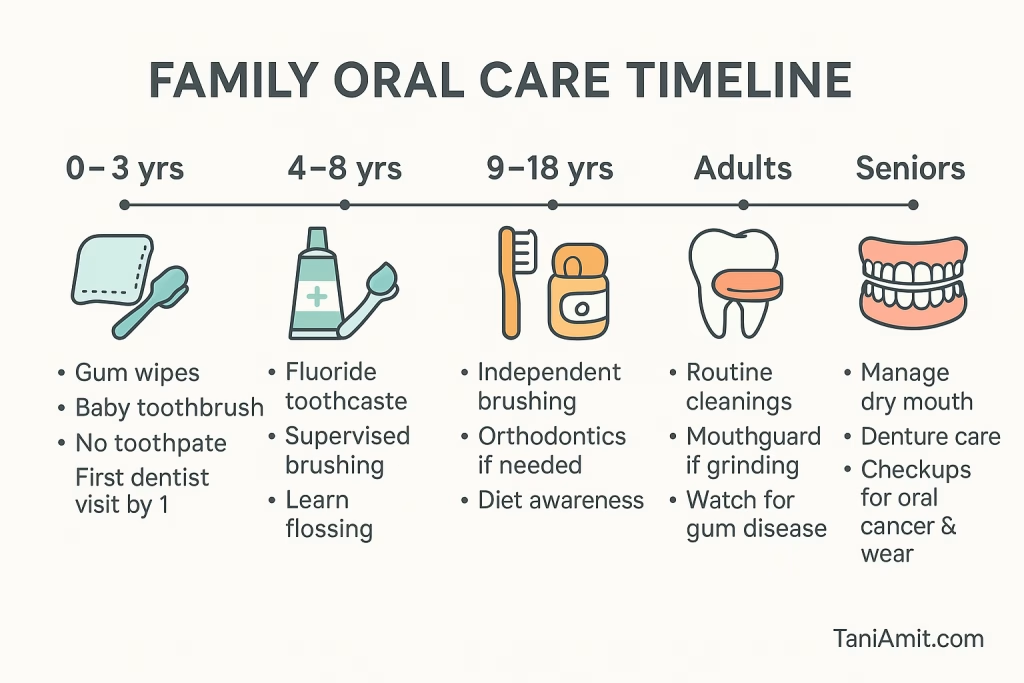
Ages 0-3:
- Clean gums with soft cloth before teeth erupt
- Use rice-sized smear of fluoride toothpaste when first teeth appear
- Parents perform brushing twice daily
- First dental visit by first birthday
- Avoid bottles during sleep (prevents baby bottle decay)
Ages 4-8:
- Pea-sized fluoride toothpaste
- Parent-assisted brushing for 2 minutes twice daily
- Introduce flossing with help
- Regular dental checkups every 6 months
- Consider sealants as permanent molars emerge
Ages 9-18:
- Independent brushing with periodic supervision
- Daily flossing or interdental cleaning
- Consider water flosser for those with braces
- Sports mouthguards if playing contact sports
- Regular dental checkups every 6 months
- Monitoring of wisdom teeth development
Adults:
- Electric toothbrush for 2 minutes twice daily
- Interdental cleaning once daily
- Tongue cleaning
- Regular dental checkups every 6 months
- Address occupation-specific risks (e.g., snacking, coffee consumption)
Seniors:
- Extra attention to gum line cleaning
- Special aids for arthritis if needed
- Dry mouth management if on medications
- More frequent dental visits (3-4 months) if high risk
- Denture or implant-specific cleaning protocols
The 2-2-2-2 Rule for Optimal Prevention
Follow our simple framework for maximum preventive benefit:
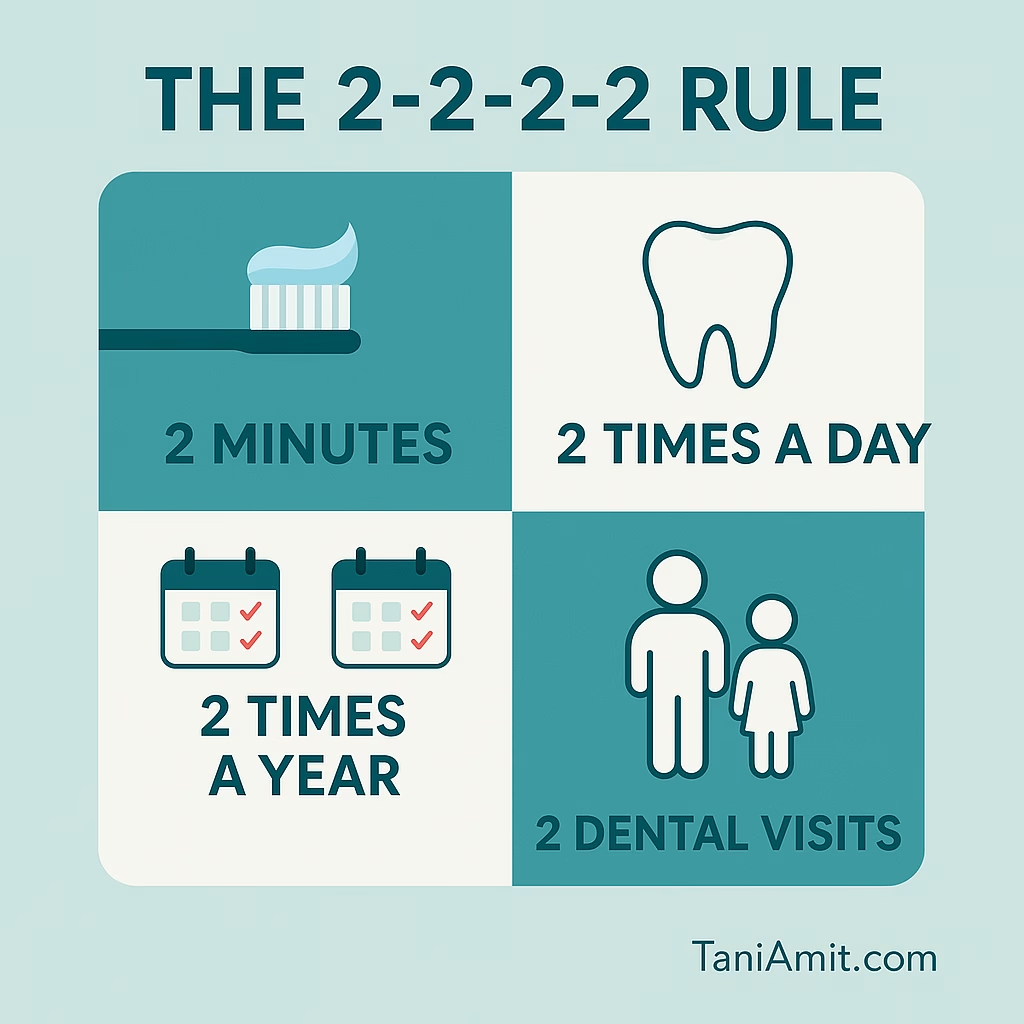
- Brush 2 times per day
- For 2 minutes each time
- Visit the dentist every 2 quarters (6 months)
- Wait 2 hours after acidic foods before brushing (prevents enamel damage)
Step 4: Schedule Professional Preventive Care Strategically
Professional care is a crucial component of prevention that should be optimized for your family’s specific needs.
Optimal Checkup Frequency by Risk Level
Not everyone requires the same schedule—personalize based on risk:
- Low risk: Adults with excellent oral health may need only annual checkups
- Moderate risk: Most children and adults benefit from twice-yearly visits
- High risk: Family members with multiple risk factors may need 3-4 visits yearly
Strategic Timing for Maximum Insurance Benefits
Most dental insurance plans in India reset benefits on a calendar year basis. Schedule strategically:
- Complete initial exams and prevention plans in January-February
- Schedule second cleanings and checkups in July-August
- Address any emerging issues by October-November before benefits expire
- Consider paying for preventive care out-of-pocket in December if you’ve exhausted benefits
Highest-Value Preventive Procedures
These professional treatments offer exceptional cost-to-benefit ratios:
- Professional cleanings (prevent gum disease and tooth loss)
- Dental sealants for children’s molars (prevent 80% of cavities)
- Professional fluoride treatments (strengthen enamel against decay)
- Diagnostic x-rays (catch problems when tiny and treatment is minimal)
- Oral cancer screenings (potentially life-saving)
- Risk assessment and personalized prevention planning
How to Negotiate Better Rates
Many dental practices offer cost-saving opportunities:
- Family package discounts (10-15% savings)
- Preventive care bundles (15-20% savings)
- Membership plans that reduce costs for families without insurance
- Advance payment discounts (5-10% savings)
- Referral credits and new patient specials
Simply asking “Do you offer any preventive care packages for families?” can save 10-20% on your annual dental expenses.
Step 5: Create Your Family’s Dental Emergency Fund
Even with excellent prevention, emergencies occasionally occur. Financial preparation ensures they don’t derail your budget.
Calculate Your Family’s Emergency Fund Requirement
Determine your specific needs based on:
- Number of family members
- Existing dental work (more restorations = higher risk)
- Sports participation (contact sports increase emergency risk)
- Genetic factors and family history
- Geographic access to emergency dental care
- Previous history of dental emergencies
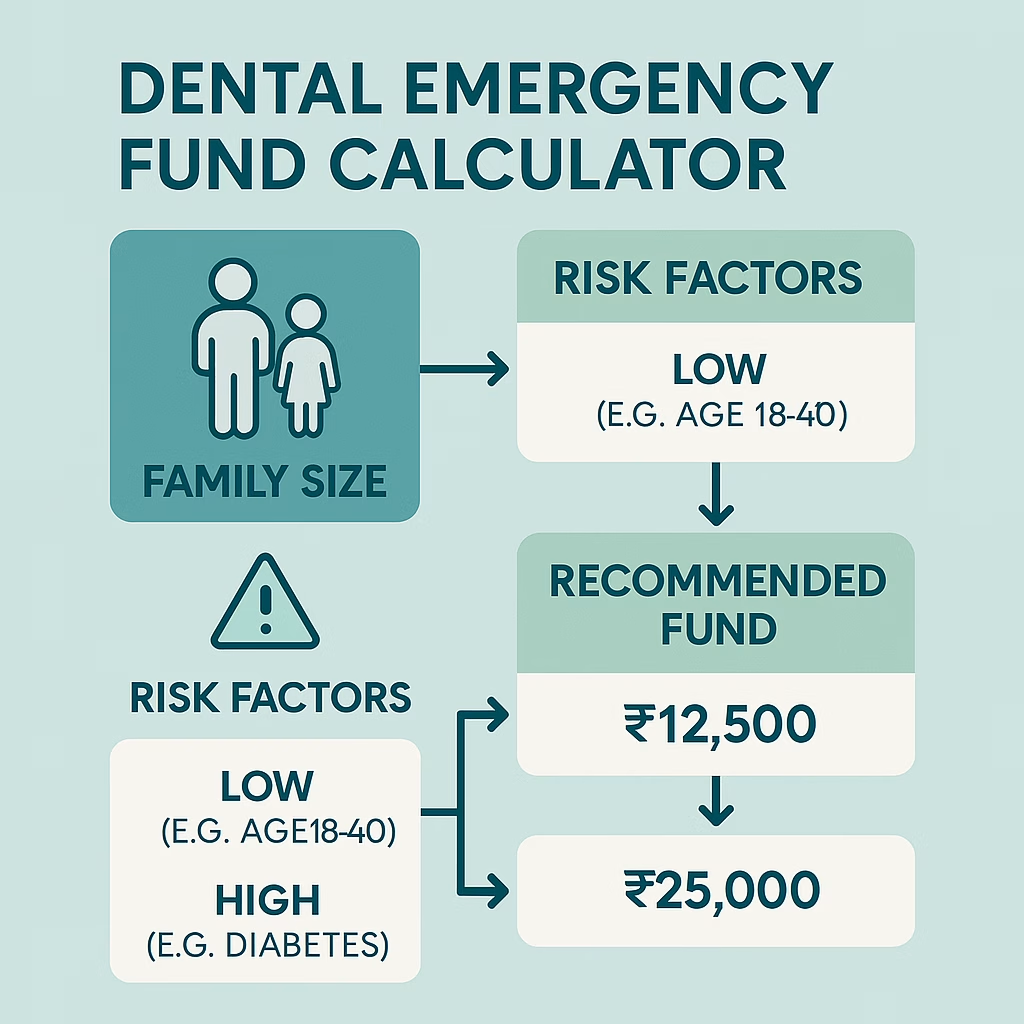
Most Indian families should maintain ₹15,000-30,000 in their dental emergency fund, though specific needs vary.
Smart Ways to Build Your Fund
- Start with an initial ₹5,000 deposit
- Set up automatic monthly transfers of ₹1,000-2,000
- Allocate a portion of annual bonuses
- Deposit the money you save from preventive care
- Consider a dedicated savings account specifically for dental expenses
- Gradually increase contributions as your income grows
Hybrid Protection Strategy
The most comprehensive approach combines multiple protection layers:
- Emergency fund for immediate needs and deductibles
- Insurance coverage for major procedures
- Discount plans or membership programs for routine care
- Health savings accounts if available through employers
- Credit options as a last resort (not as primary strategy)
Step 6: Implement Diet and Lifestyle Changes That Protect Dental Health
What your family eats and daily habits significantly impact both dental health and treatment costs.
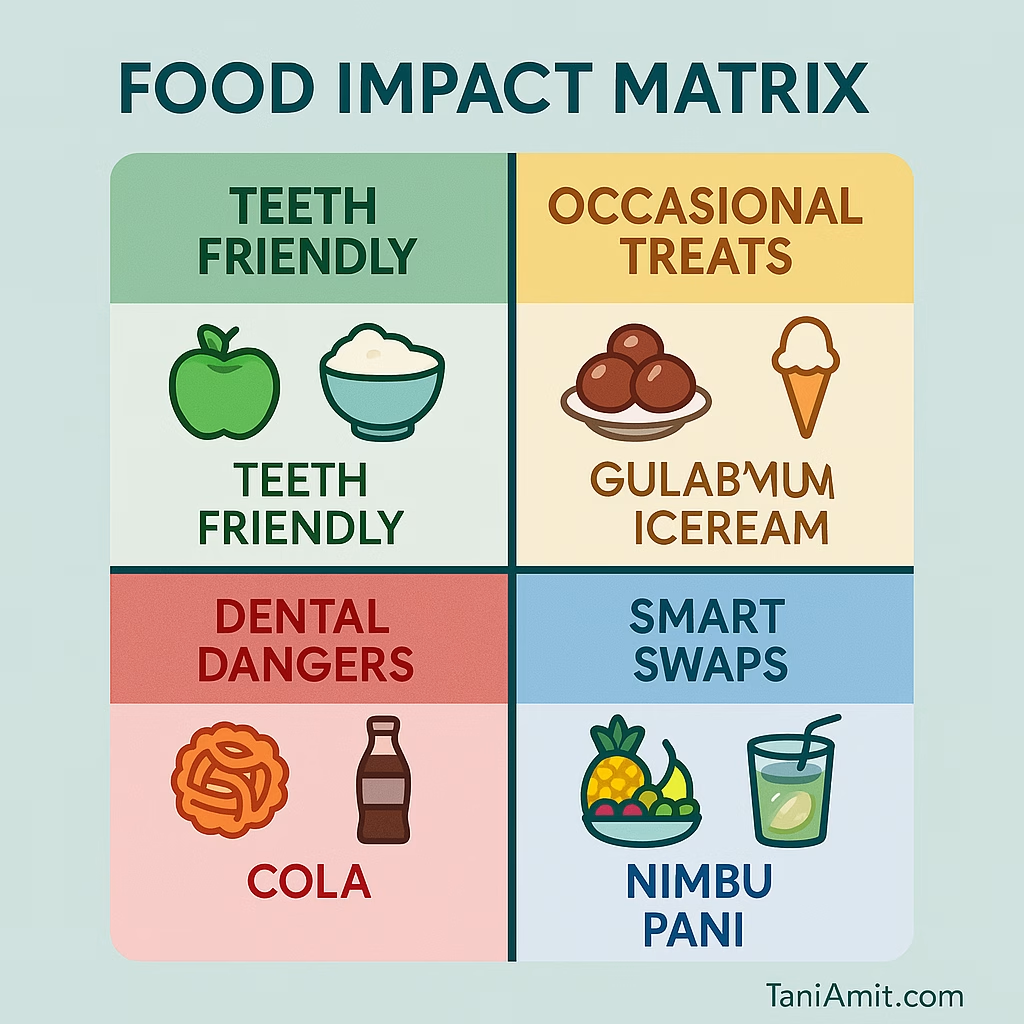
Dental Superfoods to Include Regularly
- Dairy products: Calcium and phosphates remineralize enamel
- Fibrous vegetables: Natural cleaning action while chewing
- Green tea: Antimicrobial properties reduce harmful bacteria
- Nuts and seeds: Contain minerals that strengthen teeth
- Vitamin C-rich fruits: Strengthen gums and connective tissues
- Crunchy fruits and vegetables: Stimulate saliva production, nature’s cavity fighter
Hidden Dental Damage in Common Foods
- Sticky sweets: Remain on teeth for hours after eating
- Acidic beverages: Erode enamel with each sip (pH levels below 5.5 damage teeth)
- Dried fruits: Concentrate sugars that feed bacteria
- Starchy snacks: Convert to simple sugars in the mouth
- Constant snacking: Keeps teeth under acid attack all day
- Hidden sugars: Many packaged foods contain unexpected sugar
Simple Swaps That Save Teeth and Money
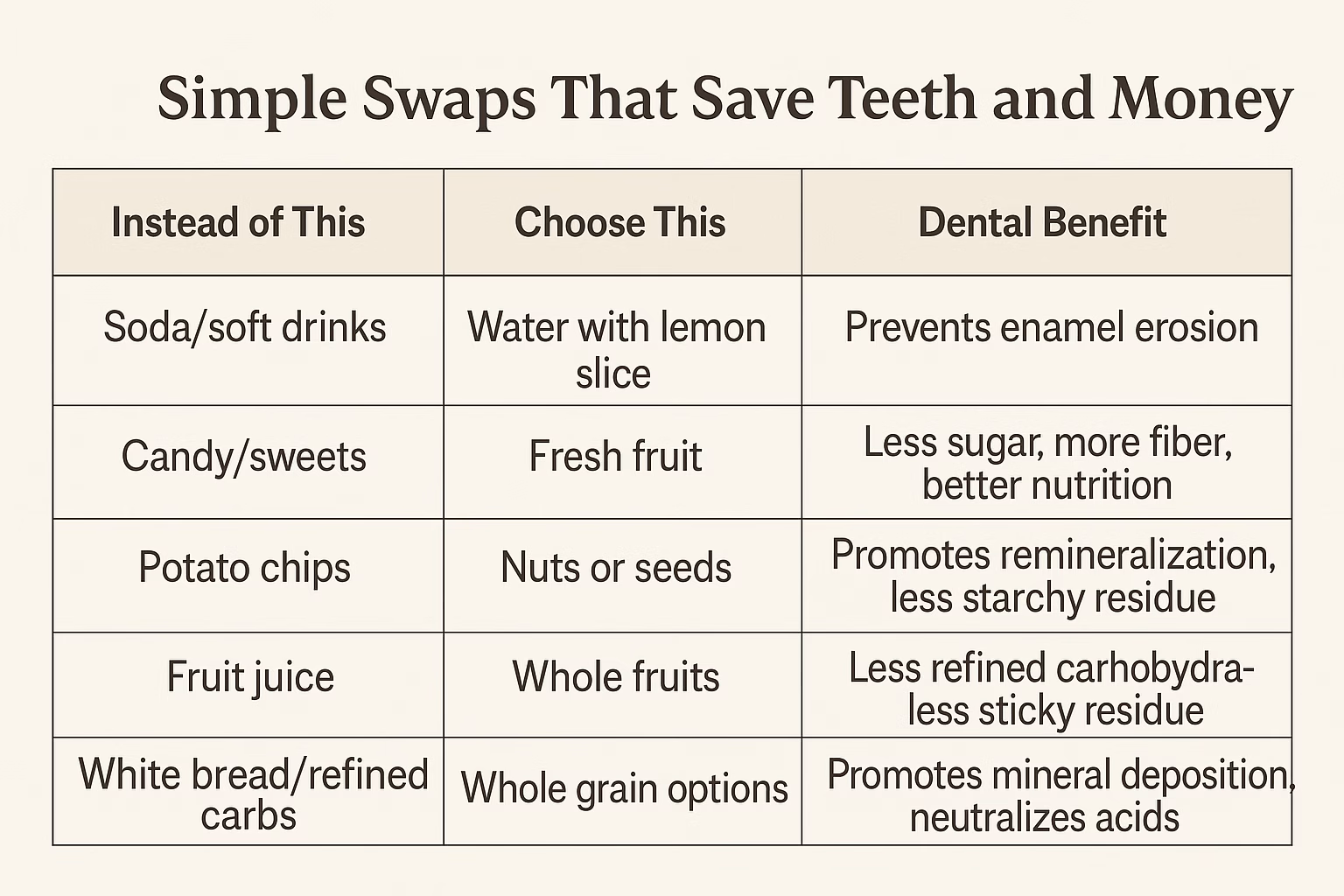
Create a Dental Wellness Environment
- Keep a water bottle accessible all day (hydration prevents dry mouth)
- Store dental floss in multiple locations (living room, office, etc.)
- Set family brushing times (morning and before bed)
- Keep healthy snacks prepared and visible
- Establish “sweet-free” days in your weekly routine
- Create reminders for replacing toothbrushes quarterly
- Use timers or musical cues for ensuring proper brushing duration
Step 7: Monitor, Track, and Adjust Your Preventive Plan
A preventive plan needs regular assessment and adjustment to maximize effectiveness.
Essential Metrics to Track
Monitor these key indicators:
- Actual vs. expected dental expenses
- Frequency of dental issues or emergencies
- Consistency of daily care routines
- Professional care appointment adherence
- Oral health improvements over time
- Cost savings compared to previous years

Quarterly Plan Review Protocol
Schedule a 30-minute family dental review every three months:
- Check in on daily habits and routines
- Review upcoming scheduled appointments
- Assess any new symptoms or concerns
- Update emergency fund status
- Celebrate improvements and prevention wins
Warning Signs Your Plan Needs Adjustment
- Bleeding gums even with regular brushing
- New sensitivity or pain
- White spots on teeth (early decay)
- Recurring bad breath
- Jaw pain or headaches from grinding
- Increased frequency of dental issues despite prevention efforts
Digital Health Record Optimization
Maintain a digital folder with:
- Dental visit summaries
- Treatment recommendations
- X-rays and images
- Payment records and receipts
- Insurance claims and coverage details
- Preventive care schedule and history
Having this information organized saves both time and money when making dental decisions.
Special Considerations for Different Family Members
Each family member needs a customized approach to prevention based on their life stage and specific risks.
Children (Ages 0-12)
- First dental visit: Schedule by first birthday or first tooth
- Sealants: Apply as soon as permanent molars erupt (typically age 6 and 12)
- Habit formation: Make brushing a fun, rewarding activity with positive reinforcement
- Orthodontic screening: Schedule by age 7 to identify potential issues early
- Sports protection: Mouthguards for active children
- Fluoride optimization: Balanced approach to ensure adequate protection without excess
Teenagers (Ages 13-19)
- Independence with accountability: Let teens manage their care but verify
- Orthodontic timing: Often most effective during teen growth spurts
- Wisdom teeth monitoring: Regular x-rays to prevent impaction problems
- Sports protection: Custom mouthguards for athletes
- Diet coaching: Address sugary drinks, frequent snacking, and acidic beverages
- Appearance motivation: Connect good oral care with aesthetics for increased compliance
Adults (Ages 20-59)
- Stress-related issues: Night guards for teeth grinding, jaw clenching
- Career impacts: Address coffee/tea staining and breath concerns
- Cosmetic considerations: Preventive care improves appearance and prevents costly treatments
- Pregnancy planning: Pre-conception dental care saves significant money
- Work-life balance: Convenient care options that fit busy schedules
- Systemic health connections: Understanding how oral health affects overall wellbeing
Seniors (Ages 60+)
- Medication effects: Managing dry mouth from common medications
- Mobility adaptations: Modified tools for arthritis or limited dexterity
- Root cavity prevention: Special focus on exposed root surfaces
- Fixed restoration maintenance: Preserving investment in crowns and bridges
- Nutrition support: Ensuring diet supports continued dental health
- Caregiver education: Training for those who assist dependent seniors
Putting It All Together: Your Family’s Complete Preventive Dental Care Plan
Creating a comprehensive preventive dental care plan for your family isn’t just about avoiding cavities—it’s a powerful financial strategy that protects both your loved ones’ health and your hard-earned money.
Reach out to us for any question or content/copywriting needs.
By following our proven seven-step framework, you’re now equipped to implement a system that can save your family thousands of rupees annually while ensuring everyone enjoys optimal oral health. Remember, prevention is always more affordable than treatment!
Our premium resources –
1.Family Dental Health Assessment Template
2.Preventive Dental Savings Calculator
3.Dental Emergency Fund Calculator
4.Dental Savings Tracker
5.Family Dental Tracker
– Get our premium resources for free
– Weekly tips that save real money
– Special info/guides not on our blog
